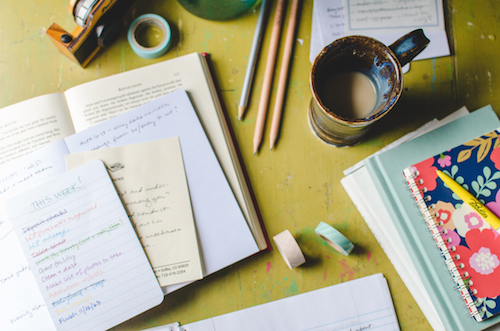 Photograph by Lindsay Crandall
Photograph by Lindsay Crandall
It’s been years since I first heard the term contemplative writer. I read it, actually, in the memoir Traveling with Pomegranates by Sue Monk Kidd and her daughter, Ann. The book chronicles the mother and daughter as they travel through Europe, each coming to terms with her own life changes and exploring what it means to be a writer. It was Ann who used the term contemplative to describe her writing, or at least the kind of writer she longed to be. When I read it, the term gripped me: contemplative writer. I wrote it in my journal and drew a giant star beside it. This is what I wanted.
At that time I already knew writing was a calling of mine, having finished graduate school a few years earlier with a degree in creative writing. Being a writer was woven into the fabric of who I am, but I was struggling. When Traveling with Pomegranates found its way into my hands, I was a new mother with a not-quite-one-year-old, wrestling with my new identity and what that meant for my work. Ann, who wrote about her own identity crisis after graduating from college, spoke right to my heart. I knew that I, too, wanted to be a contemplative writer.
To be a contemplative writer meant that I had to be a contemplative human being. I had to make space, slow down, and pay attention. I did that for a while with care and intention. I diligently wrote my morning pages, I blogged, I journaled, I wrote essays. And then life got in the way. The time I needed for reflection became more and more scarce as years went by. I still needed to create but found myself gravitating to photography and the immediate satisfaction it gave me. It was easier than struggling to make time for contemplation, for thinking and writing.
But lately I’ve felt its pull once again, a pull beyond merely being creative to actually writing. It started when I read Elizabeth Gilbert’s Big Magic. In it, she quotes Jack Gilbert, who said, “Do you have the courage? Do you have the courage to bring forth this work? The treasures that are hidden inside you are hoping you’ll say yes.” My heart leaped. Yes, of course. This is what I want: to be bold and courageous, to be thoughtful and contemplative, and to take time for myself and my writing again.
I could feel that this wasn’t just about writing, though. It was about living. I want to live a contemplative life and, as an extension of that, to be a contemplative writer. I already tend toward that kind of life. I love thinking and getting into the deep space in my mind to explore and make connections. But getting into that space in a meaningful way can be difficult because it requires time and space. If there are no empty spaces for contemplation, there is no contemplation.
So I knew I had to slow down. I needed to create space in my life and, if I was serious about this contemplation business, that would mean saying no to things that I knew weren’t good for me. I shifted from a consuming mindset to a creating one. I wanted less scrolling and more doing. I started journaling regularly in order to work through my thoughts, ask questions, and seek answers. But contemplation does not come efficiently; it comes slowly and with abundant time. Its path is not a straight line. It pushes back against stress and busyness.
Underneath all this is my desire for truth and authenticity, for something bigger than myself. That’s why I write and why I want to continue to write. That’s why I cling so desperately to this idea of the contemplative writer. It’s what I want to be; it’s who I want to be. In my head, it’s perfect and easy. Like Wendell Berry writes, “Make a place to sit down. / Sit down. Be quiet,” then “accept what comes from silence.” If only it were that easy. If only being a writer were neat and tidy. If only it didn’t mean being messy and vulnerable and often afraid. If only it didn’t mean making mistakes and forging ahead, even when it’s hard.
Anne Lamott writes in Bird by Bird that being a writer “is ultimately about asking yourself, How alive am I willing to be?” My hope is that struggling to be a contemplative writer, photographer, wife, mother, friend, social networker, blogger, and human being gives me more and more life. I hope that whatever I unearth spills out into my writing and into my art. And I hope that it spills out into my life and the way I love. I hope that the time and space it takes to be contemplative shapes me in every way and continues to fuel what Sue Monk Kidd calls “the necessary fire,” this need to search, dive deep, and share what I find.
 Photograph by Lindsay Crandall
Photograph by Lindsay Crandall
Lindsay Crandall is a writer, photographer, and half of the daily collaboration at hello there, friend. More often than not, you’ll find her with a book or camera in her hand (and sometimes a glass of red wine). She is a collector of moments, a lover of light, a daydreamer, and a goal setter. Learn more about her on her website or follow her on Instagram.
















